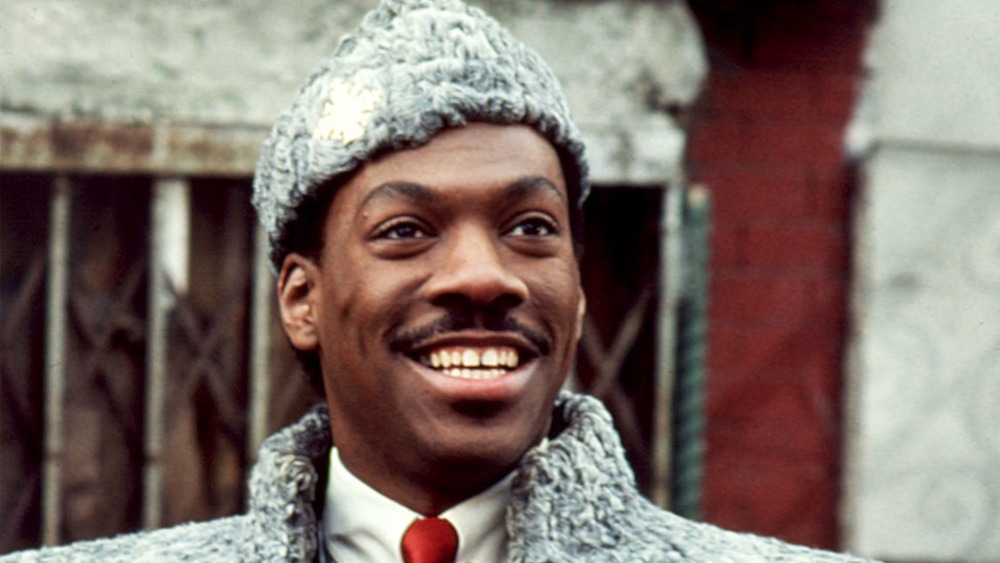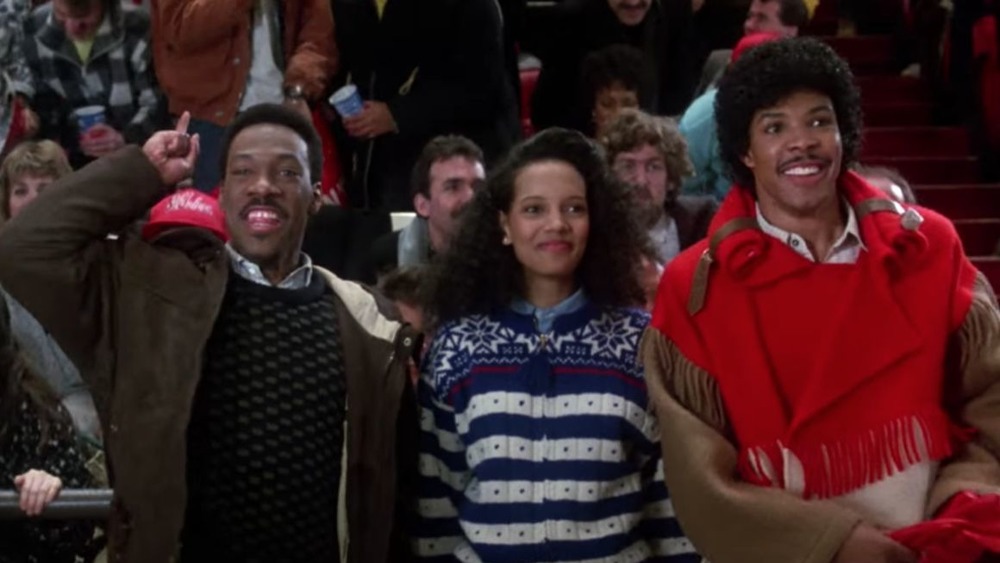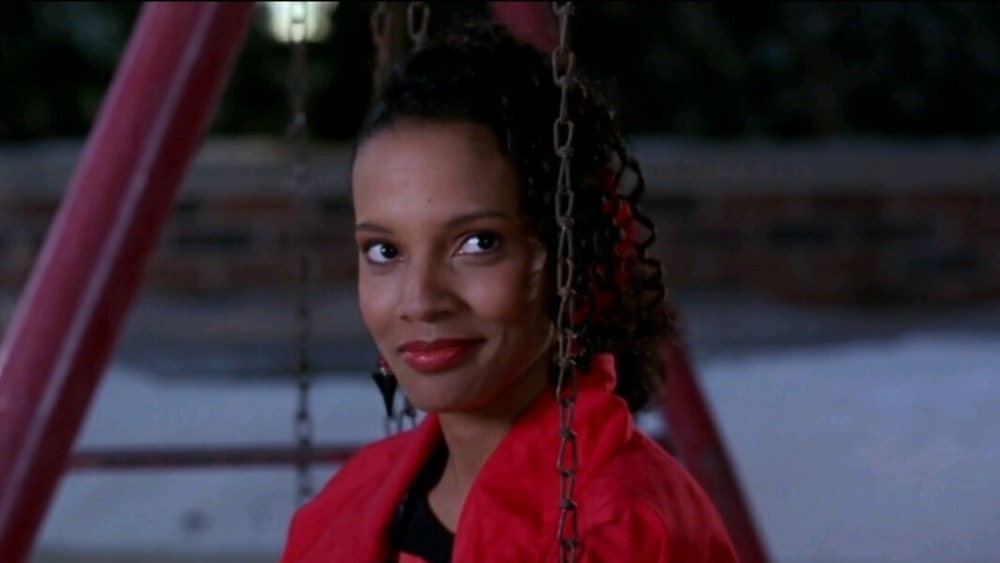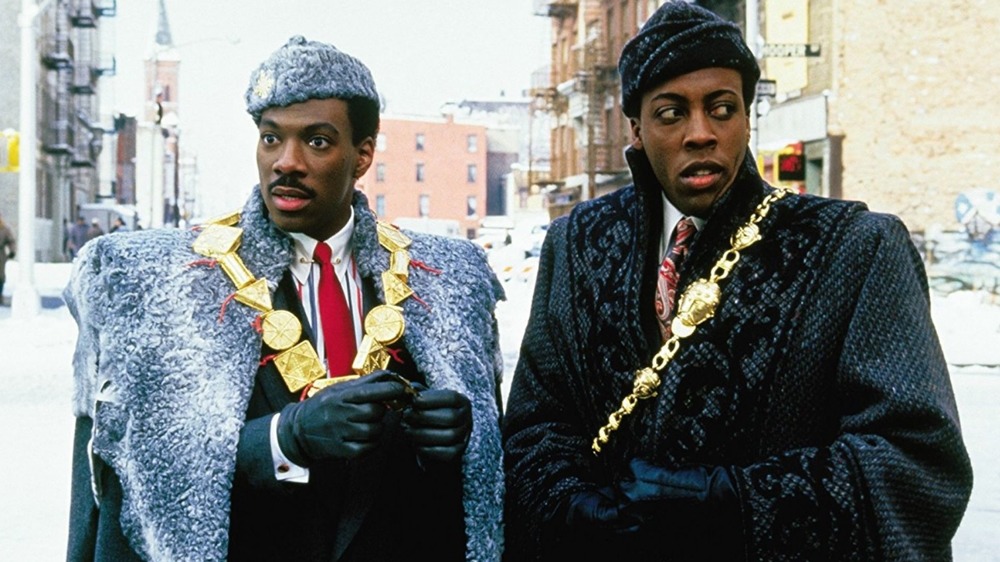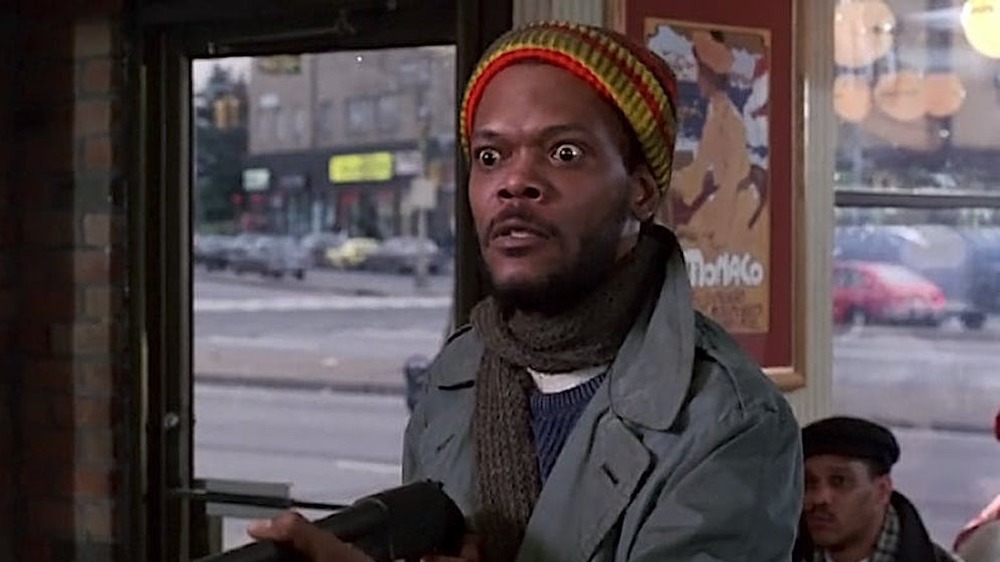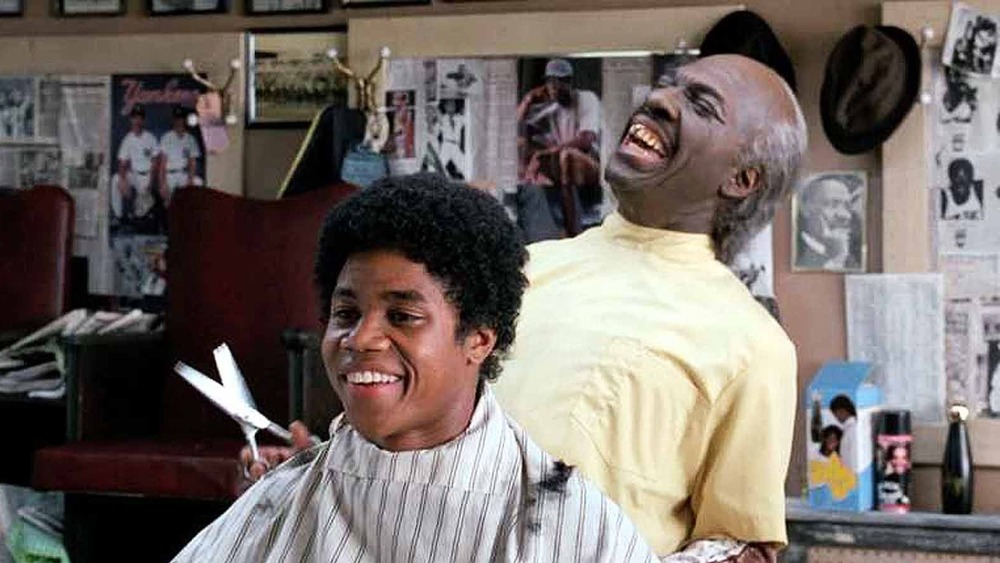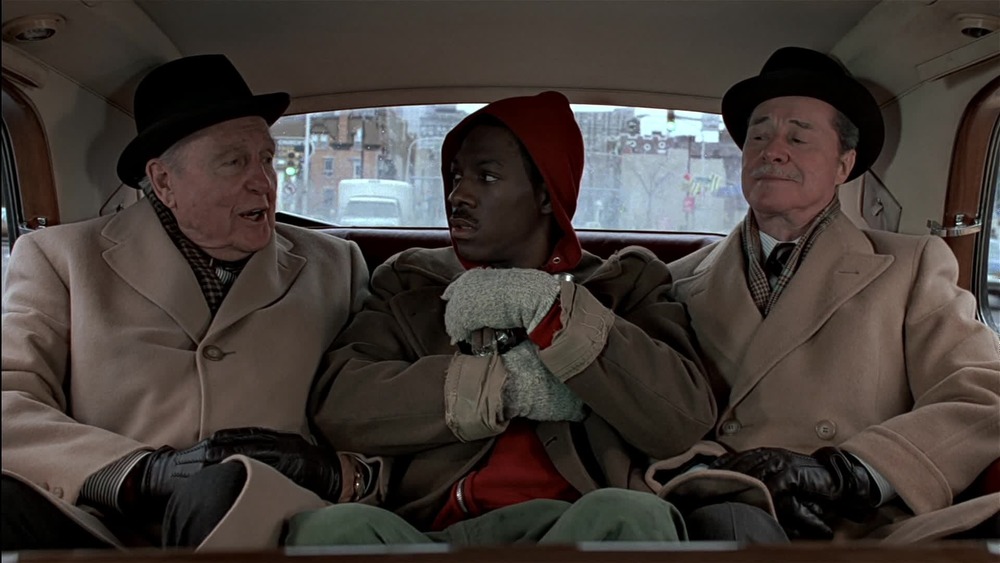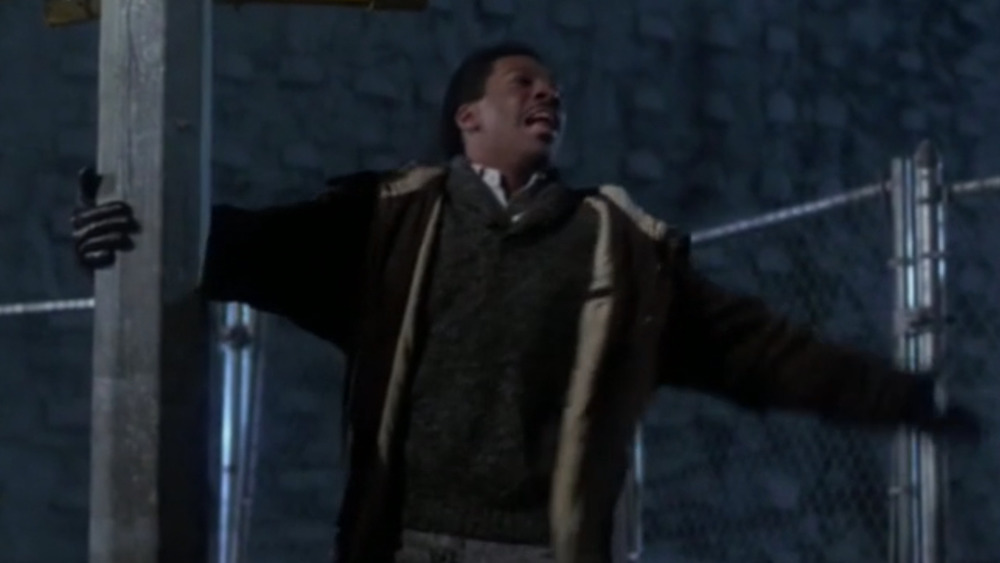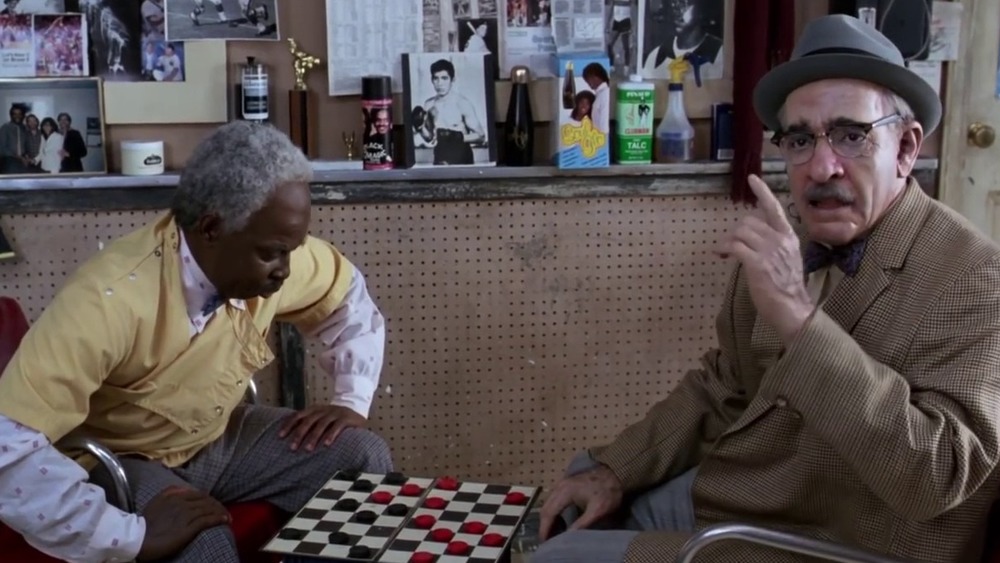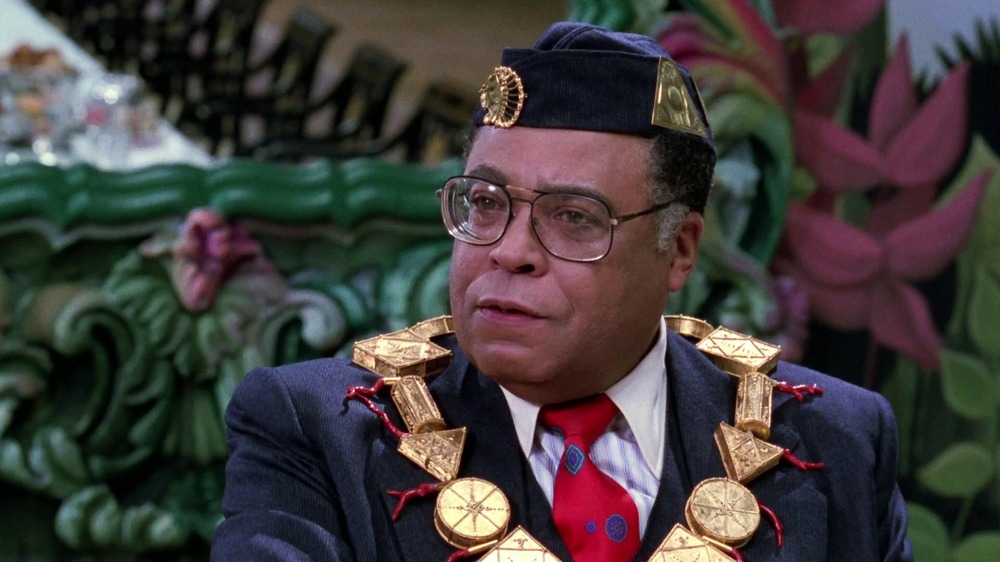Things You Missed As A Teen Watching Coming To America
The R-rated Coming to America didn't exactly fill the matinee screenings with toddlers in 1988, but that doesn't mean that only adults flocked to Eddie Murphy films. The teens of the '80s loved Eddie too, and found a way to see his movies whether they were allowed to or not. Whether they relied on cable showings, neighborhood video stores, or theater workers willing to look the other way, Murphy had millions of younger fans who helped turn R-rated hits like 48 Hrs, Trading Places, and Beverly Hills Cop into the widely beloved comedy classics they are today.
Murphy's 1988 comedy Coming to America was no exception — it received an R rating for language and nudity — though anybody who has ever seen it will tell you that it's a PG picture at heart, a fairy tale about a royal prince (Murphy) from the fictional African country of Zamunda who travels with his loyal servant Semmi (Arsenio Hall) to find a bride in — where else? — Queens. But although the movie is appropriate for older teens, only adults picked up on all of the movie's subtleties. So to mark the release of the long-awaited sequel Coming 2 America, here's a look back on the things you missed as a teen watching Coming to America.
The almost all Black cast is extremely rare for the 1980s
An almost all Black cast, while not uncommon today in movies such as One Night in Miami, Black Panther, or Judas and the Black Messiah — not to mention television shows such as Empire or Power — was virtually unheard of in the 1980s outside of The Cosby Show. There were few black movie stars (besides Murphy, the list included Richard Pryor and Danny Glover) and Black performers usually played token roles within predominantly white casts. Before Coming to America, Murphy typically played the lone Black man in a white milieu in "fish out water" comedies like 48 Hrs., Trading Places, and Beverly Hills Cop. By the time he got to Coming to America, however, Murphy was one of Hollywood's most powerful players, and could dictate the cast and director for his movies.
His next film after Coming to America, Harlem Nights, also featured a mainly Black cast, and was directed by Murphy himself, though it wasn't nearly as popular as his earlier hits. Murphy would continue populating his movies with Black performers in subsequent efforts like Boomerang, Life, and The Nutty Professor, but Coming to America, and Murphy's success in general, helped open doors for more (and more varied) depictions of Black experiences onscreen. By the early 1990s, a Black independent cinema renaissance was underway — with more Black filmmakers and performers both in front of and behind the camera — that yielded a number of classics, including Boyz n the Hood, Menace II Society, House Party, Friday, and New Jack City.
It is also gender progressive for its time
It's hard to understate just how sexist '80s comedies were. Hollywood's almost exclusively male filmmakers sexualized and objectified women in waves of cheap flicks about creepy, desperate dudes who see women as marks to conquer, spy on, manipulate, or outright trick into bed. These films included Revenge of the Nerds and its sequels, Porky's and its sequels, Bachelor Party, and Weird Science, in which teenagers literally invent a sex robot. Even in more thoughtful comedies like Trading Places or Risky Business, the main female characters (Jamie Lee Curtis and Rebecca DeMornay, respectively) are sex workers.
Not that Coming to America doesn't sexualize and objectify women, including in its early scenes. But its core plot is about Prince Akeem rejecting an arranged marriage, and the idea of a woman as property, to search for someone with whom he has a genuine connection. The woman he eventually meets, Lisa McDowell (played by Shari Headley), works for a living, is committed to serving the Black community, and eventually rejects her boyfriend Darryl for his regressive views on women after he announces their engagement without telling her. This leaves Akeem to pursue Lisa, and their courtship is characterized by the two of them getting to know each other, rather than Akeem trying to lure Lisa into bed. Crucially, Headley is not sexualized in a traditional way, through revealing costumes or typical scenes of a woman stepping out of a shower or bath.
Eddie Murphy plays a very different character than he had previously
Coming to America is firmly established as part of Eddie Murphy's '80s canon, but when watching it today, it's very striking how different Prince Akeem is from his other characters of the era. Although we now think of Murphy as someone who's had multiple phases in his acting career, including his family movie phase (the Shrek films, Dr. Dolittle, Daddy Day Care), and his serious-actor films (Dreamgirls, Dolemite Is my Name), much of Murphy's early work featured him in a loud, wisecracking, and foul-mouthed persona. These characters often got at least one big scene in which they tried to one-up or embarrass the white establishment. Famous examples include Reggie Hammond, who poses as a cop to shake down a honky-tonk bar in 48 Hrs., and Axel Foley posing as a journalist to con his way into the Beverly Palm Hotel in Beverly Hills Cop.
In Coming to America, Murphy seems to have been determined to play Akeem as, if not naïve, then wide-eyed and permanently optimistic. The prince always has a big grin on his face. He treats people with respect, and he is patient and humble. Even Murphy's famous laugh disappears into the character. Given that the film ends on a Murphy laugh, he could have pulled out the tried and true, as if to reassure the audience that it was still good old Eddie. But he stays committed to playing Akeem until the last frame.
Zamunda has a lot in common with Wakanda
Akeem is the prince of Zamunda, a fictional African country that has much in common with Wakanda from Marvel's Black Panther. Murphy himself even pointed out similarities between the fictional countries. Though Zamunda doesn't feature Wakanda's futuristic technology or vibranium, the two kingdoms are wealthy and self-sufficient with educated populations and governments that keep their distance from the outside world. Both of these imagined places are also informed by real African traditions in music, art, and dance. They are also protected by their own warrior class. While the combat in Coming to America isn't as fierce as that in Black Panther, it nevertheless presents Akeem and Semmi as skilled warriors not unlike T'Challa.
Wakanda appeared in Marvel comics in the mid-1960s at the height of the civil rights movement when Black Americans were fighting for basic rights. The 1980s saw the reduction of many of those '60s civil rights gains, as well as an increase in economic inequality between Black and white Americans. Though Coming to America could hardly be called a pointed social satire, it nevertheless portrays some of this reality in the way that it contrasts Akeem's great wealth with the distressing poverty of the Queens neighborhood that he and Semmi have come to visit. Given the struggles Black Americans have faced — as well as the brutal legacy of European colonialism in Africa — Zamunda, like Wakanda, represents dreams of agency, dignity, equality, and power for Black people.
Cameos from future stars
Eddie Murphy used the clout he'd gathered in the movie business to feature many Black performers in Coming to America — not only himself and Arsenio Hall, but also James Earl Jones, Frankie Faison, John Amos, Shari Headley, and numerous others. The token white performer in the movie is the comic Louie Anderson, who was then just getting his own career started. But even beyond those major roles, the movie features future stars in small parts. The most notable is Samuel L. Jackson, who plays a stick-up man whose attempted robbery is foiled by Akeem and Semmi. It's hard to believe there was a time when nobody knew who Jackson was, but in 1988 it would still be six years before he debated the relative merits of eating pork and the wisdom of giving the boss' girlfriend a foot massage in Pulp Fiction. Cuba Gooding, Jr. also shows up in a blink-or-you'll-miss-it cameo as a young man getting his haircut, and the future Broadway star and award-winning playwright Ruben Santiago-Hudson appears for a few moments as a street hustler.
Finally, Eriq La Salle plays Darryl Jenks, Akeem's sleazy rival for Lisa's affections, and the butt of a thousand Jheri curl jokes. Though he didn't quite become the star that Gooding or Jackson did, he did enjoy massive success and multiple Emmy nominations as Dr. Peter Benton on ER. More recently, La Salle turned up in a crucial role in the well-received X-Men film Logan.
The movie subtly weaves in Black history
Black experiences were rarely shown onscreen in the 1980s, and when they were, in movies such as The Color Purple, Mississippi Burning, or Glory, they were often shown through the eyes of white filmmakers. While Coming to America is not a "serious" movie about the Black experience — Murphy understands that viewers don't want to be preached at, especially in a comedy — it nevertheless takes advantage of its huge audience to include material on Black history and culture. The main outlet for this material is the barbershop — a hallowed space for Black Americans. Although the scenes set in the shop are uproarious and serve primarily to showcase Murphy and Hall playing an array of other characters, they educate while entertaining. The men carry on long debates about the greatest boxers, allowing younger audiences to become familiar with names like Joe Louis and Cassius Clay they may never have heard of. They also mention Kunta Kinte (of Roots) and discuss Dr. Martin Luther King.
The movie also features a long scene set at a Black Awareness rally. Murphy uses the rally as an excuse to play more comic characters in makeup, but the very existence of a scene like this in a big studio movie was virtually unheard of at the time. Coming to America gave Black audiences an opportunity to see their communities onscreen, while allowing white audiences to experience Black people beyond the usual Hollywood stereotypes of the time.
John Landis pays homage to several of his own films
Director John Landis was known for adding cameos and easter eggs to his films before the practice was as common as it is today. He often featured other directors in bit parts, such as Terry Gilliam, Joel Coen, Sam Raimi, and even George Lucas and Steven Spielberg. True to form, Coming to America has bit parts for Texas Chain Saw Massacre director Tobe Hooper and Airplane! director Jim Abrahams.
The movie also features references to other Landis movies. An opening dance sequence set in Zamunda with dancers doing flips, and Arsenio Hall's character, Reverend Brown, both pay homage to the James Brown church scene from The Blues Brothers. And careful listeners can hear the name of Frank Oz, who was also in The Blues Brothers, announced over an airport loudspeaker.
But the most famous reference is to Trading Places, Landis' 1983 hit starring Murphy and Dan Aykroyd. Murphy plays street hustler Billy Ray Valentine, who is used in a social experiment by the wealthy Duke Brothers, Randolph and Mortimer (Ralph Bellamy and Don Ameche). By the movie's end, Valentine has become rich, while simultaneously sending the Duke Brothers to the poorhouse. In Coming to America, when Prince Akeem and Lisa come across two homeless men in the park, Akeem generously gives them a wad of cash. The homeless men subsequently reveal themselves as Randolph and Mortimer, now living on the streets. "We're back in business!" cries a jubilant Mortimer.
There are also references to classic movies
Not content to only pay homage to his own films, director Landis drops a few references to other cinematic classics into Coming 2 America as well. His allusion to Citizen Kane comes early in the film when Prince Akeem and his parents, King Joffer (James Earl Jones) and Queen Aoleon (Madge Sinclair), breakfast at the royal table. The scene recalls the famous breakfast montage from Kane, when the dissolution of Charles Foster Kane's first marriage is shown at a series of progressively longer breakfast tables that signify the distance between the couple. Much as Mel Brooks had lampooned the opening shot of Star Wars a year earlier in Spaceballs, by panning underneath a spaceship for a ridiculously long time, Landis gives us a breakfast table so long that Akeem and his parents can only communicate by phones on either end.
The more obvious reference comes later in the movie, as Akeem is walking home through his neighborhood after a successful date with Lisa. In his ebullience, he sings Jackie Wilson's "To be Loved," at the top of his lungs, leaping up and grabbing a lamp post as Gene Kelly famously does in Singin' in the Rain. But though Murphy himself can carry a tune, Akeem's warbling is no match for Kelly's smooth tenor, and Akeem's neighbors curse and shout at him to shut up. Sadly for them, a man in love cannot be deterred from expressing his heart, even if his voice is terrible.
Eddie Murphy is the old guy in the barbershop
Coming to America is famous for its multiple performances by Murphy as not only Prince Akeem, but also Clarence the barber, Randy Watson — the Whitney Houston-crooning lounge singer — and the Saul, the old guy who hangs around in the barbershop. It's easy to spot Murphy as Clarence and Randy. But for those who saw the movie in the 1980s — especially before it became common for the actor to play multiple characters under layers of prosthetic makeup in movies like The Nutty Professor — it was something of a shock to discover that Murphy was also playing Saul. And it's not just that he nails the accent and the mannerisms. It's that the makeup is also flawless.
Credit Rick Baker, who did prosthetic makeup for '80s sci-fi and horror films such as Starman, The Howling, and An American Werewolf in London. Baker was responsible for creating the makeup effects for Murphy and Arsenio Hall (who also plays multiple characters) in Coming to America. He would go on to help Murphy create characters for The Nutty Professor and its sequel, becoming an indelible part of the comedian's filmic legacy.
James Earl Jones' character quotes Darth Vader
Contemporary viewers never miss a movie allusion, no matter how subtle or obscure. Thanks to the internet, and fan communities that scrutinize and report on every frame of a film the day it is released, it's almost impossible for even the most minor inference to go unnoticed. This is especially true with Star Wars, and the legions of fans devoted to every reference, Easter egg, callback and shout-out. So it's not surprising that there is no shortage of online material devoted to the slight connection between the Star Wars trilogy and Coming to America via James Earl Jones.
Given that Jones only voiced Darth Vader (David Prowse was the man inside the suit), it's possible — though unlikely — that some viewers at the time didn't make the association at all between Jones and Darth Vader. Which is why when Jones as King Joffer, searching for Prince Akeem in New York City, tells someone "Do not alert him to my presence. I shall deal with him myself," a viewer in the 1980s might not immediately smile at the thought of Vader. But the line — the way it is written and especially the way Jones delivers it — sounds exactly like a similar line of Vader's from Return of the Jedi. And if you're still not convinced, here's a breakdown of the connection by the truly devoted.
